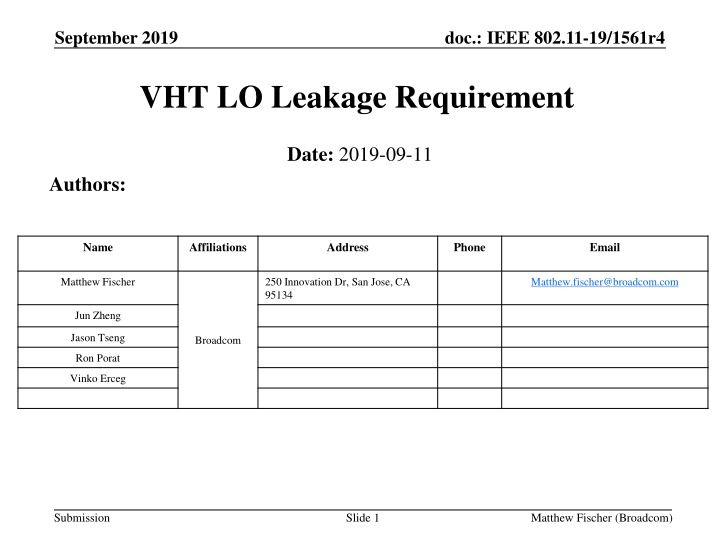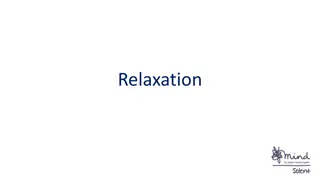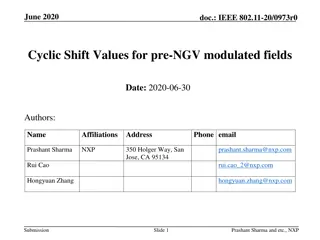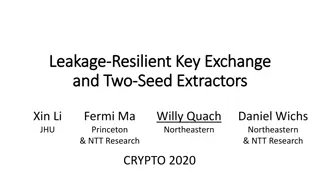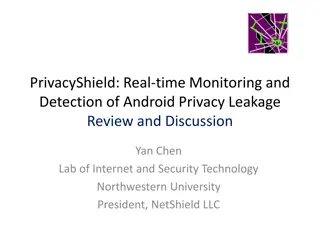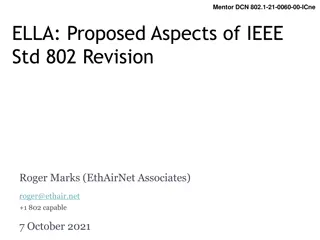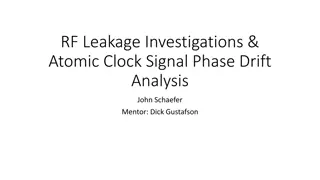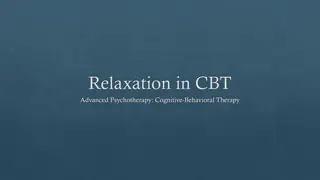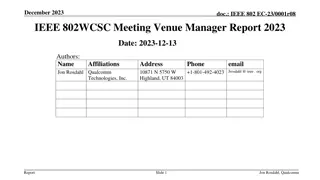Proposed Relaxation of VHT LO Leakage Limits in IEEE 802.11-19/1561r4
VHT LO Leakage limits in the IEEE 802.11-19/1561r4 standard are deemed unrealistic under reduced TX power scenarios. This document proposes a relaxation of these limits under certain conditions, suggesting amendments for a more realistic approach to addressing LO leakage. The proposal aims to ensure that TX LO leakage meets specific requirements across various formats and bandwidths, excluding specific frequency segments. The document discusses the necessity of adjustments in current dBr requirements for effective leakage power management within wireless communication systems.
Download Presentation

Please find below an Image/Link to download the presentation.
The content on the website is provided AS IS for your information and personal use only. It may not be sold, licensed, or shared on other websites without obtaining consent from the author.If you encounter any issues during the download, it is possible that the publisher has removed the file from their server.
You are allowed to download the files provided on this website for personal or commercial use, subject to the condition that they are used lawfully. All files are the property of their respective owners.
The content on the website is provided AS IS for your information and personal use only. It may not be sold, licensed, or shared on other websites without obtaining consent from the author.
E N D
Presentation Transcript
September 2019 doc.: IEEE 802.11-19/1561r4 VHT LO Leakage Requirement Date: 2019-09-11 Authors: Name Affiliations Address Phone Email Matthew Fischer 250 Innovation Dr, San Jose, CA 95134 Matthew.fischer@broadcom.com Jun Zheng Jason Tseng Broadcom Ron Porat Vinko Erceg Submission Slide 1 Matthew Fischer (Broadcom)
September 2019 doc.: IEEE 802.11-19/1561r4 Abstract VHT LO Leakage limits are unrealistic when accounting for reduced TX power situations Other proposed amendments account for reduced total TX power in a manner that is realistic This document proposes a relaxation of the VHT LO Leakage limits under certain conditions Submission Slide 2 Matthew Fischer (Broadcom)
September 2019 doc.: IEEE 802.11-19/1561r4 VHT LO Leakage Specification REVmd_D2.4 -- 21.3.17.4.2 Transmit center frequency leakage Submission Slide 3 Matthew Fischer (Broadcom)
September 2019 doc.: IEEE 802.11-19/1561r4 VHT dBr Calculation BW NST 20 56 40 114 -20.57 80 242 -23.84 160 484 -26.85 -10log10(NST) -17.48 VHT dBr When RF LO is at the center of the PPDU BW Constant dBr requirement across all TX power When RF LO is at the center of the PPDU BW Submission Slide 4 Matthew Fischer (Broadcom)
September 2019 doc.: IEEE 802.11-19/1561r4 TGax Draft 2.4 LO Leakage Specification 27.3.18.4.2 Transmit center frequency leakage Submission Slide 5 Matthew Fischer (Broadcom)
September 2019 doc.: IEEE 802.11-19/1561r4 TGax Effective dBr Requirement Leakage power = max(P 32, -20) dBr = max(P 32, -20) - P P > 12, dBr = P 32 P = -32 P < 12, dBr = -20 - P Submission Slide 6 Matthew Fischer (Broadcom)
September 2019 doc.: IEEE 802.11-19/1561r4 Comparison of Current dBr Requirements Submission Slide 7 Matthew Fischer (Broadcom)
September 2019 doc.: IEEE 802.11-19/1561r4 Proposed Changes REVmd_D2.4 -- 21.3.17.4.2 Transmit center frequency leakage TX LO leakage shall meet the following requirements for all formats and bandwidths except 80+80 MHz where the RF LO falls outside both frequency segments: When the RF LO is in the center of the transmitted PPDU BW, the power measured at the center of transmission BW using resolution BW 312.5 kHz shall not exceed the maximum of the average power per-subcarrier of the transmitted PPDU and -20 dBm, or equivalently, max(P-10log10(NST), -20 ), where P is the transmit power per antenna in dBm, and NSTis defined in Table 21-5 (Timing-related constants). When the RF LO is not at the center of the transmitted PPDU BW, the power measured at the location of the RF LO using resolution BW 312.5 kHz shall not exceed the maximum of -32 dB relative to the total transmit power and 20 dBm, or equivalently max(P 32, -20) , where P is the transmit power per antenna in dBm, and NSTis defined in Table 21-5 (Timing-related constants). For an 80+80 MHz transmission where the RF LO falls outside both frequency segments, the RF LO shall follow the spectral mask requirements as defined in 21.3.17.1 (Transmit spectrum mask). The transmit center frequency leakage is specified per antenna. Submission Slide 8 Matthew Fischer (Broadcom)
September 2019 doc.: IEEE 802.11-19/1561r4 Similar Issue for HT Specification PROPOSED CHANGE: 19.3.18.7.2 Transmit center frequency leakage For VHT STAs the requirements on transmitter center frequency leakage are defined in 21.3.17.4.2 (Transmit center frequency leakage); otherwise, the requirements are defined in this subclause. The transmitter center frequency leakage shall follow 17.3.9.7.2 (Transmitter center frequency leakage) for all transmissions in a 20 MHz channel width. For transmissions in a 40 MHz channel width, the center frequency leakage shall not exceed max(P - 20, -20) dBm 20 dB relative to overall transmitted power, or, equivalently, 0 dB relative to the average energy of the rest of the subcarriers. For upper or lower 20 MHz transmissions in a 40 MHz channel, the center frequency leakage (center of a 40 MHz channel) shall not exceed max(P 17, -20) 17 dB relative to overall transmitted power, or, equivalently, 0 dB relative to the average energy of the rest of the subcarriers. The transmit center frequency leakage is specified per antenna. Submission Slide 9 Matthew Fischer (Broadcom)
September 2019 doc.: IEEE 802.11-19/1561r4 11a Subclause 17.3.9.7.2 Transmitter center frequency leakage Certain transmitter implementations might cause(#229) leakage of the center frequency component. Such leakage (which manifests itself in a receiver as energy in the center frequency component) shall not exceed max(P 15,-20) dBm-15 dB relative to overall transmitted power or, equivalently, +2 dB relative to the average energy of the rest of the subcarriers. The data for this test shall be derived from the channel estimation phase. Submission Slide 10 Matthew Fischer (Broadcom)
September 2019 doc.: IEEE 802.11-19/1561r4 Comparison of dBr Requirements After the Proposed Changes Submission Slide 11 Matthew Fischer (Broadcom)
September 2019 doc.: IEEE 802.11-19/1561r4 Straw poll #1 Do you support the proposed change to Draft P802.11REVmd_D2.4 21.3.17.4.2 Transmit center frequency leakage 19.3.18.7.2 Transmit center frequency leakage 17.3.9.7.2 Transmitter center frequency leakage as described in 11-19-1561-04-000m-VHT-LO-Leakage- Requirement? YES NO ABS Submission Slide 12 Matthew Fischer (Broadcom)
September 2019 doc.: IEEE 802.11-19/1561r4 References [1] Draft P802.11REVmd_D2.4 [2] Draft P802.11ax_D4.3 Submission Slide 13 Matthew Fischer (Broadcom)
